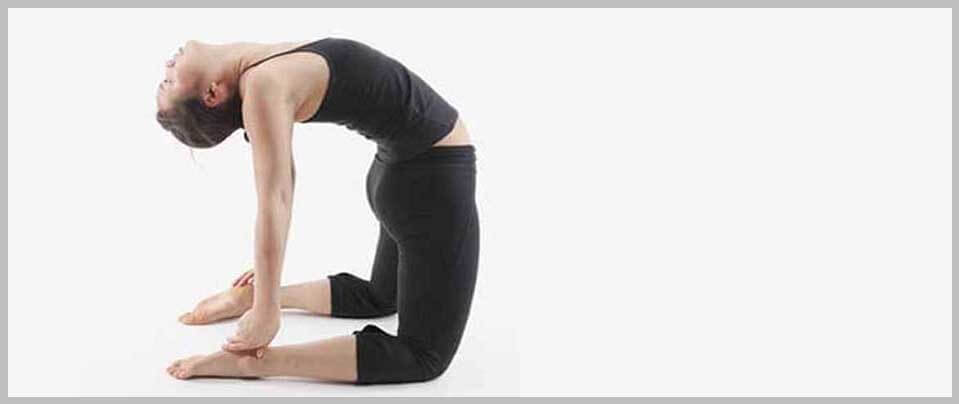
Full Camel Pose
Ustrasana, full camel pose, is highly recommended pose because it makes our body fit. Regular practice of this pose helps you improve the core strength, gain stamina, and make your hip and shoulder flexible. It is the modification of ardha-ustrasana that we discussed in our previous article. A very deep backward bend you perform in kneeling position – beginning with Vajrasana, you will first widen your knees and legs and then stand on your knees, push the hips with your palms and get into ardha-ustrasana and modify it. From the ardha-ustrasana position, you will stretch your arms first and then one at a time remove the palms from your hip and press them on your respective heels. Now push your chest by arching the back, bend your head backwards and hold this position for 30 seconds to one minute. Breathe deep and slow while in this position. Your pulse rate will increase considerably. People with low or high blood pressure, insomnia, migraine, low back or neck injury should not try Ustrasana. If you have joint related issues or undergone a knee surgery in recent past – don’t begin Ustrasana too early. Don’t do this pose if you have lower back pain – either mild or severe – this will increase the pain. If you are physically fit and confident, you can do this asana - but on your own range of limits and abilities. People with any medical concern should consult the doctor before planning further.
Getting into Camel Pose
1. Get into Ardha-Ustrasana.
2. Lengthen your back pelvis and draw the tailbone towards the pubis with your hands.
3. Inhale and press the shoulder blades to the back of your ribs to lift your heart.
4. Arc your back.
5. Remove your palms from the hips and press them against your heels – do this one at a time so you don’t lose balance. You can slightly tilt the thighs backwards while touching the heel and again press them back to perpendicular to floor after joining the hand and heel. If necessary, turn your toes under and raise the heels.
6. Turn the arms outward, the elbow creases should face forward.
7. Arch your back – your arms should be straight.
8. Drop your head back. You may also keep it at a neutral position. Don’t strain the neck or tighten the throat.
9. Breathe calm and deep. Maintain the position for 30 seconds to one minute.
10. To release, bring your hands back to your front hips. Inhale, lead with your heart, and lift your torso by pushing your hips down toward the floor. Your head should come up last. Rest in Child’s Pose (Balasana) or Corpse Pose (Savasana).
Vajrasana - Points to remember
1. You may feel pain in the legs when you begin to practice this asana. If your leg aches, undo the asana and stretch your legs. Now massage your ankles, knees and calf muscles with hand. This soothes the muscles and pain gradually fades.
2. If you have knee problem, have history of knee injury or had recent knee surgery; don’t practice Vajrasana.
3. You can still practice this asana if you are pregnant. Be cautious to keep your knees apart to not stress your abdomen.
Benefits of Camel Pose
1. Ustrasana stretches chest, abdomen, quadriceps, and hip flexors.
2. Improves spinal flexibility; strengthens shoulders and back muscles, thighs and arms; tones organs of abdomen, pelvis and neck; reduces fat on thighs; loosens up the vertebrate; opens up the hips; and improves posture.
3. Energizes the body, reduces anxiety and fatigue.
4. Stimulates endocrine glands, kidneys and digestive system stretching the abdomen and also curse constipation.
5. Stimulates and improves respiratory and nervous systems by proper blood circulation.
6. Activates thyroid glands.
7. Ustrasana helps to heal and balance the chakras.